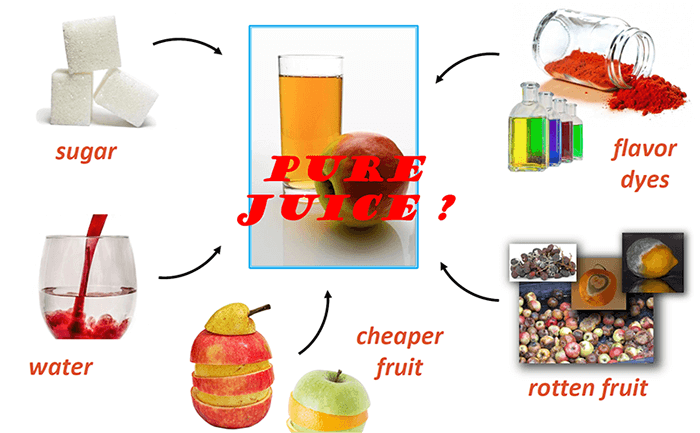Fruit juice is a very popular kind of beverage worldwide, and is considered as healthy drink due to its high levels of antioxidants, micronutrients, polyphenols, especially anthocyanins. These components have been reported to show many health benefits, such as the prevention of cancer, improvement of digesting system, as well as anti-inflammation. However, the increasing popularity of fruit juice products makes them frequent targets for adulterations. Therefore, it is essential to check fruit juice adulteration in order to protect consumer health and maintain the market order of fruit juice industry.
The most common forms of adulteration include dilution with water, substitution or mixing with cheaper or rotten fruit juices, as well as external addition of sugars, acids, flavors, or dyes (Figure 1). Lifeasible is the world leader in authenticity testing by providing a comprehensive portfolio of methods dedicated to the detection of different types of adulterants in fruit juices.
 Figure 1. The most common forms of fruit juice adulteration (Wistaff et al.)
Figure 1. The most common forms of fruit juice adulteration (Wistaff et al.)
The prices of sugars or syrups, such as inverted cane syrup (PICS), beet sucrose (BS), high fructose corn syrup (HFCS), and a synthetic solution of fructose, glucose, and sucrose (FGS), is significantly cheaper than the juice itself, thus these sugars are frequently added to fruit juice to increase profit. The adulteration of C4 sugars (e.g., corn and cane syrups) can be detected by the ratio of 13C to 12C, which is of higher content in C4 sugars (-9‰ to -15‰) than in C3 sugars (-23‰ to -28‰); and this ratio can be measured using stable isotope ratio analysis (SIRA) technique. Similarly, these ratios of 2H to 1H and 18O to 16O can be used to detect adulteration of C3 sugars and water addition, respectively. Moreover, spectral profiles produced by near-infrared (NIR) spectroscopy or total reflectance Fourier transform mid-infrared (ART-FTMIR) also allow the detection of sugars such as glucose, fructose, and inverted cane sugar to fruit juices. Additionally, the profiling of carbohydrates can be analyzed by many chromatographic methods. For example, Oligosaccharide profiling by capillary gas chromatography can be used to detect the addition of inulin syrup, invert sugar, and HFCS.
Substitution or blending of expensive fruit juices (e.g., pomegranate, citrus, and various types of berries juices) with cheaper (e.g., apple, pear, grape juices and so on) or rotten ones is another common form of adulteration in fruit juice industry. The profiling of carbohydrates, organic acids, polyphenols, and amino acids may vary in different fruit juices, and can be used as markers to discriminate adulteration with inferior fruit juices. For instance, the chalcones phloretin glucoside and phloretin xyloglucoside are characteristic compounds found in apple juice, while isohamnetin glucoside is typically present in pear juice. These metabolic fingerprinting can be established through different chromatographic methods (e.g., high-performance liquid chromatography (HPLC) or gas chromatography coupled to various types of separations columns and detectors, thin layer chromatography (TLC), ultra-high-performance liquid chromatography-quadrupole time-of-flight mass spectrometry (UPLC-QTOF MS), etc.), spectroscopic methods (e.g., Raman, near-infrared (NIR), mid-infrared (MIR), FT, and nuclear magnetic resonance (NMR)) , electrophoresis (capillary electrophoresis), and so on.
Besides advanced analytical technologies, our food testing laboratories also provide multivariate data analysis to help clients find the major variation between different fruit juices. The multivariate analysis methods include linear discriminant analysis (LDA), partial least-squares discriminant analysis (PLS-DA), orthogonal partial least-squares discriminant analysis (OPLS-DA), soft independent modeling of class analogy (SIMCA), and so on.
With excellent experts in food biochemistry and statistics, our state-of-the-art laboratories can provide robust, high-sensitivity, and fast services for detection of adulterants in juice products. Welcome to contact us for technical consults and inquiries.
Reference
Lifeasible has established a one-stop service platform for plants. In addition to obtaining customized solutions for plant genetic engineering, customers can also conduct follow-up analysis and research on plants through our analysis platform. The analytical services we provide include but are not limited to the following:
Get Latest Lifeasible News and Updates Directly to Your Inbox
Adaptive Evolutionary Mechanism of Plants
February 28, 2025
Unraveling Cotton Development: Insights from Multi-Omics Studies
February 27, 2025